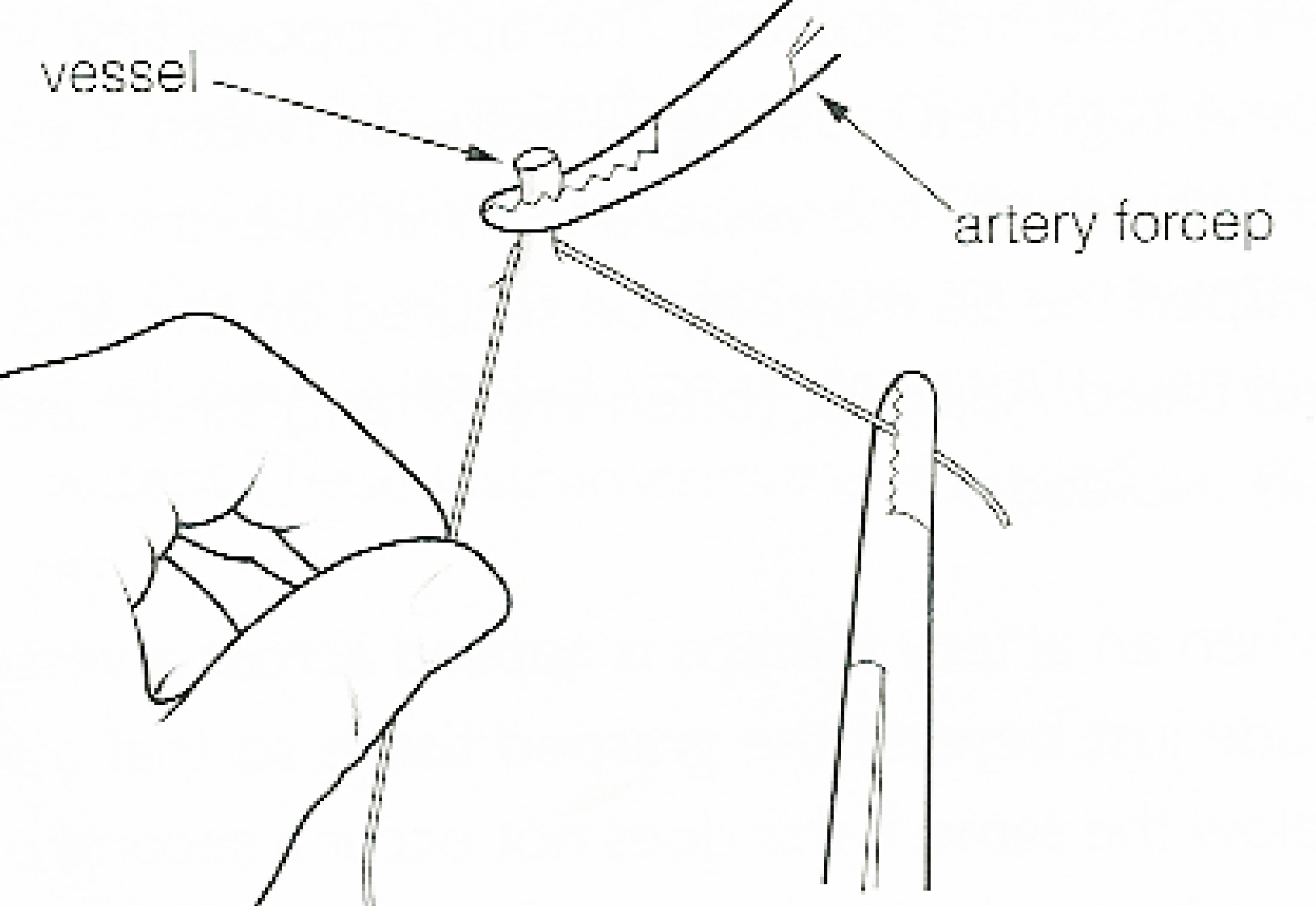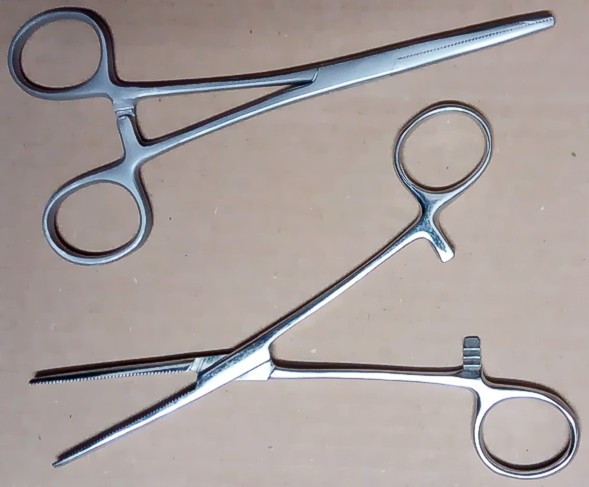|
Ligation (medicine)
In surgery or medical procedure, a ligature consists of a piece of thread ( suture) tied around an anatomical structure, usually a blood vessel or another hollow structure (e.g. urethra) to shut it off. History The principle of ligation is attributed to Hippocrates and Galen. In ancient Rome, ligatures were used to treat hemorrhoids. The concept of a ligature was reintroduced some 1,500 years later by Ambroise Paré, and finally it found its modern use in 1870–80, made popular by Jules-Émile Péan. Procedure With a blood vessel the surgeon will clamp the vessel perpendicular to the axis of the artery or vein with a hemostat, then secure it by ligating it; i.e. using a piece of suture around it before dividing the structure and releasing the hemostat. It is different from a tourniquet in that the tourniquet will not be secured by knots and it can therefore be released/tightened at will. Ligature is one of the remedies to treat skin tag, or acrochorda. It is done by tying stri ... [...More Info...] [...Related Items...] OR: [Wikipedia] [Google] [Baidu] |
Ligature
Ligature may refer to: * Ligature (medicine), a piece of suture used to shut off a blood vessel or other anatomical structure ** Ligature (orthodontic), used in dentistry * Ligature (music), an element of musical notation used especially in the medieval and Renaissance periods * Ligature (instrument), a device used to attach a reed to the mouthpiece of a woodwind instrument * Ligature (writing), a combination of two or more letters into a single symbol (typography and calligraphy) * Ligature (grammar), a morpheme that links two words See also * Ligature strangulation {{disambig ... [...More Info...] [...Related Items...] OR: [Wikipedia] [Google] [Baidu] |
Surgical Suture
A surgical suture, also known as a stitch or stitches, is a medical device used to hold body tissues together and approximate wound edges after an injury or surgery. Application generally involves using a needle with an attached length of thread. There are numerous types of suture which differ by needle shape and size as well as thread material and characteristics. Selection of surgical suture should be determined by the characteristics and location of the wound or the specific body tissues being approximated. In selecting the needle, thread, and suturing technique to use for a specific patient, a medical care provider must consider the tensile strength of the specific suture thread needed to efficiently hold the tissues together depending on the mechanical and shear forces acting on the wound as well as the thickness of the tissue being approximated. One must also consider the elasticity of the thread and ability to adapt to different tissues, as well as the memory of the threa ... [...More Info...] [...Related Items...] OR: [Wikipedia] [Google] [Baidu] |
Urethra
The urethra (from Greek οὐρήθρα – ''ourḗthrā'') is a tube that connects the urinary bladder to the urinary meatus for the removal of urine from the body of both females and males. In human females and other primates, the urethra connects to the urinary meatus above the vagina, whereas in marsupials, the female's urethra empties into the urogenital sinus. Females use their urethra only for urinating, but males use their urethra for both urination and ejaculation. The external urethral sphincter is a striated muscle that allows voluntary control over urination. The internal sphincter, formed by the involuntary smooth muscles lining the bladder neck and urethra, receives its nerve supply by the sympathetic division of the autonomic nervous system. The internal sphincter is present both in males and females. Structure The urethra is a fibrous and muscular tube which connects the urinary bladder to the external urethral meatus. Its length differs between the sexes, ... [...More Info...] [...Related Items...] OR: [Wikipedia] [Google] [Baidu] |
Hippocrates
Hippocrates of Kos (; grc-gre, Ἱπποκράτης ὁ Κῷος, Hippokrátēs ho Kôios; ), also known as Hippocrates II, was a Greek physician of the classical period who is considered one of the most outstanding figures in the history of medicine. He is traditionally referred to as the "Father of Medicine" in recognition of his lasting contributions to the field, such as the use of prognosis and clinical observation, the systematic categorization of diseases, or the formulation of humoral theory. The Hippocratic school of medicine revolutionized ancient Greek medicine, establishing it as a discipline distinct from other fields with which it had traditionally been associated (theurgy and philosophy), thus establishing medicine as a profession. However, the achievements of the writers of the Hippocratic Corpus, the practitioners of Hippocratic medicine, and the actions of Hippocrates himself were often conflated; thus very little is known about what Hippocrates actually t ... [...More Info...] [...Related Items...] OR: [Wikipedia] [Google] [Baidu] |
Galen
Aelius Galenus or Claudius Galenus ( el, Κλαύδιος Γαληνός; September 129 – c. AD 216), often Anglicized as Galen () or Galen of Pergamon, was a Greek physician, surgeon and philosopher in the Roman Empire. Considered to be one of the most accomplished of all medical researchers of antiquity, Galen influenced the development of various scientific disciplines, including anatomy, physiology, pathology, pharmacology, and neurology, as well as philosophy and logic. The son of Aelius Nicon, a wealthy Greek architect with scholarly interests, Galen received a comprehensive education that prepared him for a successful career as a physician and philosopher. Born in the ancient city of Pergamon (present-day Bergama, Turkey), Galen traveled extensively, exposing himself to a wide variety of medical theories and discoveries before settling in Rome, where he served prominent members of Roman society and eventually was given the position of personal physician to several emp ... [...More Info...] [...Related Items...] OR: [Wikipedia] [Google] [Baidu] |
Hemorrhoid
Hemorrhoids (or haemorrhoids), also known as piles, are vascular structures in the anal canal. In their normal state, they are cushions that help with stool control. They become a disease when swollen or inflamed; the unqualified term ''hemorrhoid'' is often used to refer to the disease. The signs and symptoms of hemorrhoids depend on the type present. Internal hemorrhoids often result in painless, bright red rectal bleeding when defecating. External hemorrhoids often result in pain and swelling in the area of the anus. If bleeding occurs, it is usually darker. Symptoms frequently get better after a few days. A skin tag may remain after the healing of an external hemorrhoid. While the exact cause of hemorrhoids remains unknown, a number of factors that increase pressure in the abdomen are believed to be involved. This may include constipation, diarrhea, and sitting on the toilet for long periods. Hemorrhoids are also more common during pregnancy. Diagnosis is made by lookin ... [...More Info...] [...Related Items...] OR: [Wikipedia] [Google] [Baidu] |
Ambroise Paré
Ambroise Paré (c. 1510 – 20 December 1590) was a French barber surgeon who served in that role for kings Henry II, Francis II, Charles IX and Henry III. He is considered one of the fathers of surgery and modern forensic pathology and a pioneer in surgical techniques and battlefield medicine, especially in the treatment of wounds. He was also an anatomist, invented several surgical instruments, and was a member of the Parisian barber surgeon guild. In his personal notes about the care he delivered to Captain Rat, in the Piémont campaign (1537–1538), Paré wrote: ''Je le pansai, Dieu le guérit'' ("I bandaged him and God healed him"). This epitomises a philosophy that he used throughout his career. These words, inscribed on his statue in Laval, are reminiscent of the Latin adage '' medicus curat, natura sanat''. Early life Paré was born in 1510 in Bourg-Hersent, near Laval, then part of the province of Maine, in northwestern France. As a child he watched, and was fir ... [...More Info...] [...Related Items...] OR: [Wikipedia] [Google] [Baidu] |
Jules-Émile Péan
Jules-Émile Péan (29 November 1830 – 20 January 1898) was one of the great French surgeons of the 19th century. Péan was born in 1830 in Marboué, french department of Eure-et-Loir. He studied at the college of Chartres and then studied medicine in Paris under Auguste Nélaton. He was appointed a doctor in 1861 and worked at St. Antoine and St. Louis up to 1893. He then created with its expenses the international hospital. He wrote two volumes of private clinics (1876 and 1890). He was elected to the French Académie Nationale de Médecine on November 22, 1887, and was awarded the rank of Commander of Legion of Honor in 1893. He died on January 20, 1898 in Paris. A street, Rue Péan, was named after him in Châteaudun, Cloyes-sur-le-Loir and Paris. Péan was very admired and a follower of hygiene, he disputed the discoveries of Louis Pasteur. He refused to dissect corpses and operated preferably in residence. Although a teacher, he was never named professor. He was t ... [...More Info...] [...Related Items...] OR: [Wikipedia] [Google] [Baidu] |
Hemostat
A hemostat (also called a hemostatic clamp, arterial forceps, or pean after Jules-Émile Péan) is a surgical tool used in many surgical procedures to control bleeding. For this reason, it is common in the initial phases of surgery for the initial incision to be lined with hemostats which close blood vessels awaiting ligation. Hemostats belong to a group of instruments that pivot (similar to scissors, and including needle holders, tissue holders and various clamps) where the structure of the tip determines its function. The hemostat has handles that can be held in place by their locking mechanism. The locking mechanism is typically a series of interlocking teeth, a few on each handle, that allow the user to adjust the clamping force of the pliers. When locked together, the force between the tips is approximately 40 N (9 lbf). History The earliest known drawing of a pivoting surgical instrument dates back to 1500 BC on a tomb at Thebes, Egypt. Later Roman bronze and steel piv ... [...More Info...] [...Related Items...] OR: [Wikipedia] [Google] [Baidu] |
Tourniquet
A tourniquet is a device that is used to apply pressure to a limb or extremity in order to stop the flow of blood. It may be used in emergencies, in surgery, or in post-operative rehabilitation. A simple tourniquet can be made from a stick and a rope, but the use of makeshift tourniquets has been reduced over time due to their ineffectiveness compared to a commercial and professional tourniquet. This may stem the flow of blood, but side effects such as soft tissue damage and nerve damage may occur. Types There are three types of tourniquets: surgical tourniquets, emergency tourniquets, and rehabilitation tourniquets. Surgical tourniquets Silicone ring tourniquets, or elastic ring tourniquets, are self-contained mechanical devices that do not require any electricity, wires or tubes. The tourniquet comes in a variety of sizes. To determine the correct product size, the patient's limb circumference at the desired occlusion location should be measured, as well as their bloo ... [...More Info...] [...Related Items...] OR: [Wikipedia] [Google] [Baidu] |
Skin Tag
A skin tag, or acrochordon (pl. acrochorda), is a small benign tumor that forms primarily in areas where the skin forms creases (or rubs together), such as the neck, armpit and groin. They may also occur on the face, usually on the eyelids. Though tags up to half an inch (12.7 mm) long have been seen, they are typically the size of a grain of rice. The surface of an acrochordon may be smooth or irregular in appearance and is often raised from the surface of the skin on a fleshy stalk called a peduncle. Microscopically, an acrochordon consists of a fibrovascular core, sometimes also with fat cells, covered by an unremarkable epidermis. However, tags may become irritated by shaving, clothing, jewellery or eczema. Etiology Skin tags are thought to occur from skin rubbing against skin, since they are so often found in skin creases and folds. Studies have shown existence of low-risk human papillomaviruses 6 and 11 in skin tags, hinting at a possible role in their pathogenesis, alt ... [...More Info...] [...Related Items...] OR: [Wikipedia] [Google] [Baidu] |



_-_Veloso_Salgado.png)




